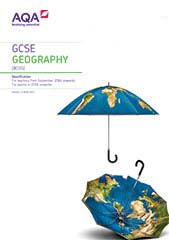3.4 Geographical skills
Students are required to develop and demonstrate a range of geographical skills, including cartographic, graphical, numerical and statistical skills, throughout their study of the specification. Skills will be assessed in all three written exams. Ordnance Survey (OS) maps or other map extracts may be used in any of the three exams.
Cartographic skills
Cartographic skills relating to a variety of maps at different scales.
Atlas maps:
- use and understand coordinates – latitude and longitude
- recognise and describe distributions and patterns of both human and physical features
- maps based on global and other scales may be used and students may be asked to identify and describe significant features of the physical and human landscape on them, eg population distribution, population movements, transport networks, settlement layout, relief and drainage
- analyse the inter-relationship between physical and human factors on maps and establish associations between observed patterns on thematic maps.
Ordnance Survey maps:
- use and interpret OS maps at a range of scales, including 1:50 000 and 1:25 000 and other maps appropriate to the topic
- use and understand coordinates – four and six-figure grid references
- use and understand scale, distance and direction – measure straight and curved line distances using a variety of scales
- use and understand gradient, contour and spot height
- numerical and statistical information
- identify basic landscape features and describe their characteristics from map evidence
- identify major relief features on maps and relate cross-sectional drawings to relief features
- draw inferences about the physical and human landscape by interpretation of map evidence, including patterns of relief, drainage, settlement, communication and land-use
- interpret cross sections and transects of physical and human landscapes
- describe the physical features as they are shown on large scale maps of two of the following landscapes – coastlines, fluvial and glacial landscapes
- infer human activity from map evidence, including tourism.
Maps in association with photographs:
- be able to compare maps
- sketch maps: draw, label, understand and interpret
- photographs: use and interpret ground, aerial and satellite photographs
- describe human and physical landscapes (landforms, natural vegetation, land-use and settlement) and geographical phenomena from photographs
- draw sketches from photographs
- label and annotate diagrams, maps, graphs, sketches and photographs.
Graphical skills
Graphical skills to:
- select and construct appropriate graphs and charts to present data, using appropriate scales – line charts, bar charts, pie charts, pictograms, histograms with equal class intervals, divided bar, scattergraphs, and population pyramids
- suggest an appropriate form of graphical representation for the data provided
- complete a variety of graphs and maps – choropleth, isoline, dot maps, desire lines, proportional symbols and flow lines
- use and understand gradient, contour and value on isoline maps
- plot information on graphs when axes and scales are provided
- interpret and extract information from different types of maps, graphs and charts, including population pyramids, choropleth maps, flow-line maps, dispersion graphs.
Numerical skills
Numerical skills to:
- demonstrate an understanding of number, area and scales, and the quantitative relationships between units
- design fieldwork data collection sheets and collect data with an understanding of accuracy, sample size and procedures, control groups and reliability
- understand and correctly use proportion and ratio, magnitude and frequency
- draw informed conclusions from numerical data.
Statistical skills
Statistical skills to:
- use appropriate measures of central tendency, spread and cumulative frequency (median, mean, range, quartiles and inter-quartile range, mode and modal class)
- calculate percentage increase or decrease and understand the use of percentiles
- describe relationships in bivariate data: sketch trend lines through scatter plots, draw estimated lines of best fit, make predictions, interpolate and extrapolate trends
- be able to identify weaknesses in selective statistical presentation of data.
Use of qualitative and quantitative data
Use of qualitative and quantitative data from both primary and secondary sources to obtain, illustrate, communicate, interpret, analyse and evaluate geographical information.
Examples of types of data:
- maps
- fieldwork data
- geo-spatial data presented in a geographical information system (GIS) framework
- satellite imagery
- written and digital sources
- visual and graphical sources
- numerical and statistical information.
Formulate enquiry and argument
Students should demonstrate the ability to:
- identify questions and sequences of enquiry
- write descriptively, analytically and critically
- communicate their ideas effectively
- develop an extended written argument
- draw well-evidenced and informed conclusions about geographical questions and issues.
Literacy
Most communication is through the written word, raising the importance of good literacy skills. Students should be able to communicate information in ways suitable for a range of target audiences.
